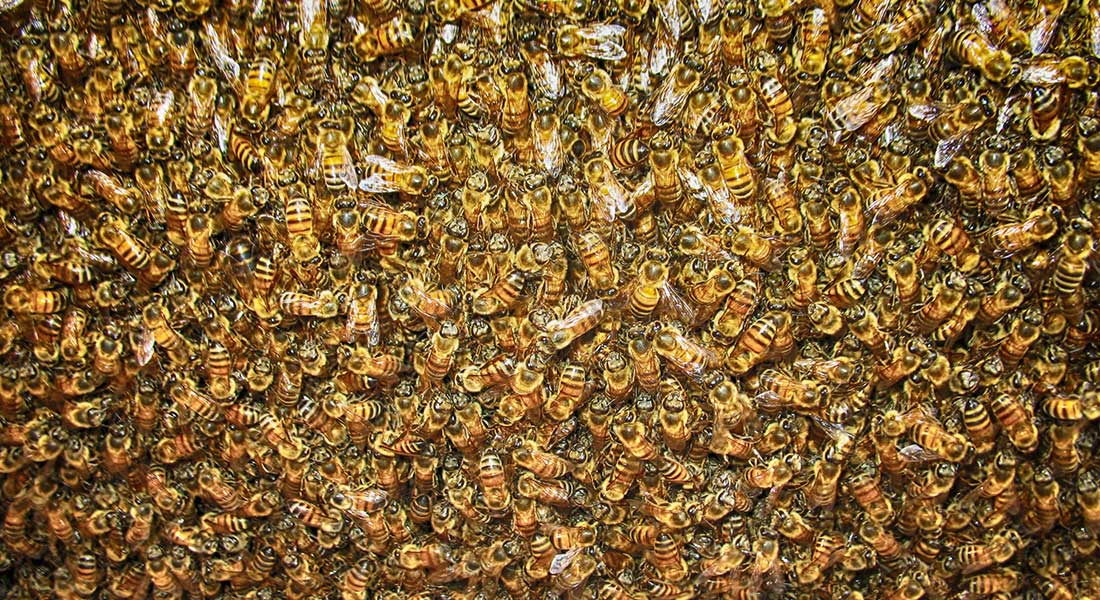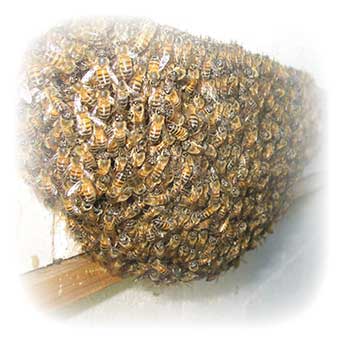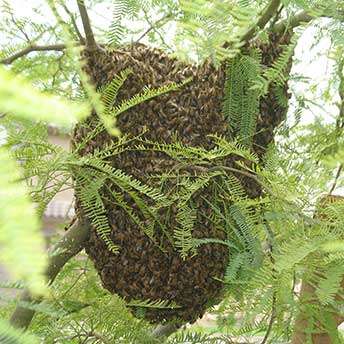Arizona Africanized Honey Bee Facts and Information

Population and Habits of Africanized Bees in Arizona and the Southwest
In Southwestern U.S. the Africanized bee population has exploded in the last couple decades. Arizona has one of the highest populations of Africanized bees in the U.S. and continues to grow year after year. The Africanized honey bees have taken a shine to the central Arizona desert and thrive in the spring and summer months.
A brief history of Africanized bees
Africanized bees, also known as killer bees, are hybrids of the African honey bee which is a hostile and invasive species. This Africanized honey bee will violently attack humans and animals that come near their hive which has earned them the nickname of killer bees. Africanized bees are extremely protective of their hive and are very easily provoked. This can lead to injuries and even fatalities.
These bees can be found on every continent except Antarctica.
Looking back at the history, the Africanized bees in America began in 1957 when the replacement bee-keeper accidentally released 26 Tanzanian queen bees and drones which were being used for research purposes. A biologist named Kerr was trying to breed the African honeybees with a European bee species so that the offspring could produce more honey and could easily adapt to tropical conditions.

After the accidental released, the bees started to breed with the Brazilian bees and produced what we now know as Africanized honeybees or as the media likes to say killer bees. Their descendants have spread throughout the Americas since the 50's and continue to spread every year.
Nesting habits of the Africanized Honey Bee
Africanized honey bees are not picky when it comes to where they will nest and build a hive. Commonly Africanized bees can be found nesting in tires, boxes, rotted logs, holes, cracks in homes and buildings. Valve boxes are a regular spot for Africanized bees and can lead to a lot of unintentional attacks on landscapers and homeowners. Africanized bees choose a lot of unusual spots to call home and can become extremely difficult to treat.
The Dangers of Africanized Honey Bees
The most common way of being attacked by Africanized bees is just simply by not paying attention and being aware of your surroundings. Africanized bees are sprinkled all throughout the Arizona desert and during the spring and summer months can become a danger to outdoors enthusiast.
Africanized honey bees can reproduce rapidly producing a few thousand bees a week and the danger level goes up the hotter it gets. They can become a lot more agitated during the heat of the summer just like we can. The threat level of bees goes up exponentially during the summer.
Once the bees have had some time to settle and get comfortable it can become an all-out war zone around their hive and any unsuspecting human or animal is fair game. Africanized bees are very territorial and once established they can become a danger to anything unfortunate enough to come across their path.
Over the years we have seen everything from horses, pigs, dogs, and birds to name a few who did not live thru their Africanized bee encounter. Another reason it is important to give your pets and escape route when home alone and left outdoors. Too many times we've seen or heard reports of pets trapped in backyards with no escape from attacking bees provoked by an inexperienced person trying to treat bees on a neighboring property.
People who try to treat active hives themselves can become a danger to everyone around them. Trying to treat an established Africanized bee colony can end up getting neighbors and their pets injured. This is a real common occurrence in the Summer around Phoenix and in Central Arizona.
Ways to help avoid an encounter with Africanized Bees
When out hiking, going off trail can lead to an unintentional encounter with Africanized bees and can quickly become a dangerous situation. It is always important when enjoying Arizona outdoors to be aware of your surroundings and to stay on trails and marked paths. Every year reports of someone that has been attacked by bees going off trail and could have easily been avoided if they had stayed on the trail.
Areas that aren't frequented on a regular basis by humans are areas that you need to be more aware.
What to do if you encounter an Africanized bee attack
Get away quickly and safely. Cover your face and try to shield your eyes to protect them in a way you can still see where you are going. Africanized bees will lock onto your face and this will become the most targeted area. Do not stop and try to fend off the bees by waving your arms around. This will not help and only cause more aggravation and aggression from the bees. Just keep moving far and fast.
Avoid water as it will not help, the bees will simply wait for you to surface and continue their assault.
If you come across someone else being attacked, do not try to help them by running towards them. Yell for them to run away and seek shelter. One person being attacked can quickly turn into multiple people being attacked if unaware of what to do.
Colony Collapse Disorder (CCD)
The are many challenges facing honey bees these days and many causes being blamed for those challenges. The truth of the matter is in many cases we simply don't know. One of the greatest challenges they are facing is Colony Collapse Disorder (CCD).
CCD is characterized by a hive that still has its queen but is missing most or all of its adult bees, with a distinct lack of dead bees around and near the hive to explain where the adult workers went. Bees do not normally abandon a hive while there are capped brood-eggs planted in cells that have been sealed.
Other clear signs of CCD are the presence of these capped broods, as well as stored honey and pollen. In addition, attacks by the usual moths and mites, as well as robber bees that would normally take immediate advantage of a weak or abandoned hive, are significantly delayed and the noticeable time lapse before these critters begin to attack If there is no queen, then it is simply assumed the hive died because of a lack of queen so her presence is one of the requirements for it to be CCD.
What Causes CCD?
While there has been considerable speculation as to the causes of CCD, there is no clear answer yet. While unsubstantiated claims have blamed everything from cell phone signals to satellite signals, if these do have an effect on the honey bee it is not related to CCD.
The majority of research now seems to indicate that CCD is caused by the perfect storm of environmental and biological factors. So basically you take a colony that is already weakened from poor nutrition and over migration, add the presence of environmental factors like pesticides that further weaken the immune system. This does not explain where the missing bees went, just the possible conditions that might create the environment for CCD. The only common factor found in over 95% of all hives infected with CCD is a pathogen transmitted by Varroa mites called Israeli acute paralysis virus (IAPV). This is not believed to be the direct cause of CCD, it is another indicator that CCD is what is causing the collapse of a fallen hive.
The bottom line is nobody is sure what is causing this and there is no evidence that it is getting worse or spreading until further extensive research is done the actual causes of CCD are mere speculation.
General Bee Precautions:
- ALWAYS be aware of your surroundings
Listen for buzzing indicating a nest or swarm of bees
Use care when entering sheds or outbuildings where bees may nest
Examine work area before using lawn mowers weed cutters and other power equipment
Examine areas before tying up or penning pets or livestock
Be alert when participating in all outdoor sports and activities
Don’t disturb a nest or swarm – contact a pest control company or an emergency response organization
Teach children to be cautious and respectful of all bees
Check with a doctor about bee sting kits and procedures if sensitive to bee stings
Develop a safety plan for your home and yard
Treat all bees as if they were Africanized always better safe than sorry
Cinnamon and Honey Cure-All?
Honey is the only food on the planet that will not spoil or rot. What it will do is what some call 'turning to sugar'. In reality, honey is always honey. However, when left in a cool dark place for a long time it will "crystallize". When this happens, loosen the lid, boil some water and sit the honey container in the hot water, but turn off the heat and let it liquefy naturally. It is then as good as it ever was. Never boil honey or put it in a microwave. This will kill the enzymes in the honey.
Cinnamon and Honey:
Bet the drug companies won't like this one getting around. Facts on Honey and Cinnamon: It is found that a mixture of honey and Cinnamon cures most diseases. Honey is produced in most of the countries of the world. Scientists of today also accept honey as a 'Ram Ban' (very effective) medicine for all kinds of diseases. Honey can be used without side effects for any kind of diseases. Today's science says that even though honey is sweet when it is taken in the right dosage as a medicine, it does not harm even diabetic patients. Weekly World News, a magazine in Canada, in its issue dated 17 January 1995 has given the following list of diseases that can be cured by honey and cinnamon, as researched by western scientists:
HEART DISEASES:
Make a paste of honey and cinnamon powder, apply it on bread instead of jelly and jam and eat it regularly for breakfast. It reduces the cholesterol in the arteries and saves the patient from heart attack. Also, those who have already had an attack, when they do this process daily, they are kept miles away from the next attack. Regular use of the above process relieves loss of breath and strengthens the heartbeat. In America and Canada, various nursing homes have treated patients successfully and have found that as a person ages the arteries and veins lose their flexibility and get clogged; honey and cinnamon revitalize the arteries and the veins.
The list of crops that simply won't grow without honey bees is a long one: Apples, cucumbers, broccoli, onions, pumpkins, carrots, avocados, almonds ... and it goes on.
Without bees to pollinate many of our favorite fruits and vegetables, the United States could lose $15 billion worth of crops -- not to mention what it would do to your diet.
Beekeepers first sounded the alarm about disappearing bees in 2006. Seemingly healthy bees were simply abandoning their hives in mass, never to return. Researchers call the mass disappearance Colony Collapse Disorder, and they estimate that nearly one-third of all honeybee colonies in the country have vanished.
During early spring, the lengthening days and new sources of pollen and nectar stimulate brood rearing. The bees also gather water to regulate temperature and to liquefy thick or granulated honey in the preparation of brood food. Drones will be absent or scarce at this time of the year.
Later in the spring, the population of the colony expands rapidly and the proportion of young bees increases. As the population increases, the field-worker force also increases. Field bees may collect nectar and pollen in greater amounts than are needed to maintain brood rearing, and surpluses of honey or pollen may accumulate).
As the days lengthen and the temperature continues to increase, the cluster expands further and drones are produced. With an increase in brood rearing and the accompanying increase in adult bees, the nest area of the colony becomes crowded. More bees are evident at the entrance of the nest. A telltale sign of overcrowding is to see the bees crawl out and hang in a cluster around the en trance on a warm afternoon.
Combined with crowded conditions, the queen also increases drone egg laying in preparing for the natural division of the colony by swarming. In addition to rearing workers and drones, the bees also prepare to rear a new queen. A few larvae that would normally develop into worker bees are fed a special gland food called royal jelly, their cells are reconstructed to accommodate the larger queen, and her rate of development is sped up. The number of queen cells produced varies with races and strains of bees as well as individual colonies.
Regardless of its crowded condition, the colony will try to expand by building new combs if food and room are available. These new combs are generally used for the storage of honey, whereas the older combs are used for pollen storage and brood rearing.
Why Do Bees Swarm?
When the first virgin queen is almost ready to emerge, and before the main nectar flow, the colony will swarm during the warmer hours of the day. The old queen and about half of the bees will rush in mass out of the entrance. After flying around in the air for several minutes, they will cluster on the limb of a tree or similar object. After the Swarm is all together and ready to go the Queen will take off and start her migration journey.
In Arizona, honey bee swarms can travel for miles searching stopping along the way searching for a new place to call home. Once they stop and rest the queen sends out scouts and searches the area for food and water and a new place to call home. This cluster of bees can remain on a limb of a tree for up to 3-4 days. Sometimes it will only remain there for an hour or so it all depends on the area and how comfortable the bees are. It also depends on the time taken to find a new home by scouting bees.
When a location is found, the cluster breaks up and flies to it. Upon reaching the new location, it will only take the bees several minutes to climb inside and get to work. Combs are quickly constructed, brood rearing starts, and nectar and pollen are gathered. Swarming generally occurs in the Arizona from March to June, although it can occur at almost any time and start as early as February depending on the weather in the desert.



